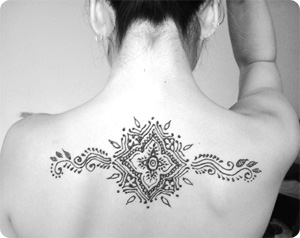Mehendi As A Tradition

Many historical events say that Mehandi is the Art of Arabic Muslims who brought henna to India, where it has bloomed into its own exclusive art style. In Indian Mehandi, a person applies designs conventionally to a woman's hands and feet. For particularly auspicious occasions, men also apply Mehandi. The most auspicious occasion justifying Mehandi artwork is the Indian wedding, where both bride and bridegroom apply henna, as well as several members of the bridal party. Henna on any time symbolizes fruitfulness. At the wedding, henna artwork further represents the love between married couple.
Mehandi came into use because of its cooling healing effect in a hot weather conditions and in India, it was also a way for a bride and groom to get to know one another before an agreed marriage. A variety of traditions underlie the use of Mehandi, including wedding games and legends. For example, the groom's name is usually written somewhere within thebride's Mehandi; if he cannot find his name within the complicated design, the bride is said to have the command in the marriage. Also, a dark Mehandi design for both bride and groom signifies that the two will have a strong relationship. Within the past few years, Mehandi has become popularized in the West by musicians and Hollywood personalities alike, and is now a quickly rising trend among women and men in world culture.
Occasions to wear Mehandi design - The Hindu marriages are special occasions for Henna tattoos. Although Mehandi is generally used in many Hindu festivals and celebrations, there's no doubt that Hindu wedding has become synonymous with this beautiful reddish dye. Hindus often use the term 'Mehandi' interchangeably with marriage, and Mehandi is considered among the most auspicious jewelleries of a married woman.
- Mehandi is not just a way of artistic expression; sometimes it's a 'must to wear factor' in Indian weddings. A Hindu wedding includes a number of religious resources previously and during the marriages. Mehandi play a very important part in it, so much so that no Indian marriage is considered absolute without it
- Mehandi is admired and accepted with both men and women also as a conditioner and dye for the hair. Mehandi is also applied during the various fasts observed by married women. It is believed widely that a large Mehandi dot in the middle of the hand, with four smaller ones at the sides denotes the presence of gods Ganesha and Lakshmi.
- A bride's wedding plan usually includes a hidden writing of the groom's name on her palm. It's believed, if the groom fails to find his name within the complicated outlines, the bride will be more leading in marital life. Sometimes the wedding night is not allowed to commence until the groom has found the names. Hence 'name game' is the other occasion for Mehandi to wear.
Dresses to match with Mehandi
With regional exceptions, if you wish to be a conventional Hindu bride, you wear a wedding gown, which is generally said as a "sari" in maroon color representing fertility, prosperity and wholesomeness. Guests and all visitors of the function should respect the customs and the women should wear long dresses and both genders should cover their arms to avoid causing any unintentional offence.
'Haldi', the turmeric paste is applied to the groom's body before he bathes and he usually is supposed to wear a 'tikka' or a 'tilak' on his forehead.
| |
Other Categories
Body Art With Henna
Henna For Hair
Mehendi As A Tradition
Henna Patterns And Techniques
History Of Mehandi-Art Of Beautifying Hands
Mehendi Art In The West
Tips To Apply Mehandi
Tips For Making Henna Paste
Main Categories
Body Care
Foot Care
Hair Care
Makeup
Mehendi
Nail Care
Skin Care
Cosmetic Surgery
Beauty Trends and Tips
Body Piercing
Stretch Marks
Tattoo Art
Carrier Oils
Cellulite
Day Spa
Essential Oils
Lip Care
|

